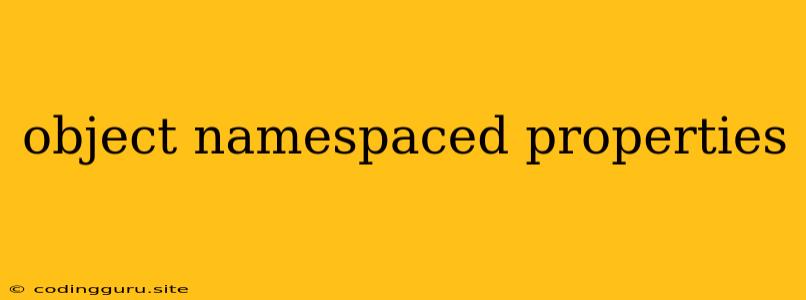Object Namespaced Properties: A Powerful Tool for Organizing Your Code
In the world of JavaScript, objects are fundamental building blocks, offering a way to group related data and functions together. This organization becomes even more potent with the concept of object namespaced properties, a technique that provides a structured approach to managing complex data structures within your JavaScript code.
Let's dive into the benefits and applications of object namespaced properties, exploring how they enhance code readability, maintainability, and overall organization.
Why Use Object Namespaced Properties?
Imagine building a complex application with many different components and features. You'll need to manage a vast amount of data, each associated with specific functions and behaviors. Without a structured approach, your code could quickly become a tangled mess, making it difficult to understand, debug, and maintain. This is where object namespaced properties shine.
Object namespaced properties provide a hierarchical organization for your data within an object, allowing you to create logical namespaces that encapsulate related data and functionality. These namespaces act as containers, grouping properties and methods under a specific "umbrella," making your code more readable, maintainable, and modular.
How Do Object Namespaced Properties Work?
Essentially, object namespaced properties are properties within an object that are accessed using a dot notation, similar to how you access regular properties. However, instead of directly accessing a single property, you're accessing a property within a nested object that acts as a namespace.
Here's a simple example:
const myData = {
user: {
name: "John Doe",
email: "[email protected]"
},
settings: {
theme: "light",
language: "en"
}
};
console.log(myData.user.name); // Output: "John Doe"
console.log(myData.settings.language); // Output: "en"
In this example, we have a myData object with two namespaces: user and settings. Each namespace holds its own set of properties. We access these properties using a dot notation, first accessing the namespace and then the property within that namespace.
Benefits of Object Namespaced Properties
-
Improved Code Organization: The hierarchical structure created by object namespaced properties makes your code significantly more organized. It avoids cluttering your code with a large number of unrelated properties, promoting readability and maintainability.
-
Reduced Naming Conflicts: By grouping properties under namespaces, you minimize the chances of naming conflicts, especially when working with large and complex codebases.
-
Enhanced Modularity: Object namespaced properties contribute to modularity, allowing you to easily isolate and manage specific parts of your application. This makes it easier to update, reuse, and test individual modules without affecting other parts of your code.
-
Easier Debugging and Maintenance: The well-defined structure of object namespaced properties makes debugging significantly easier. You can quickly locate and isolate the relevant section of code responsible for a particular problem.
Real-World Applications of Object Namespaced Properties
Object namespaced properties have a wide range of applications in JavaScript development, especially in:
-
Front-End Development: When building user interfaces with JavaScript frameworks like React or Vue, object namespaced properties can help you organize components, states, and props. This makes your code more readable, maintainable, and scalable.
-
Back-End Development: In server-side JavaScript applications using Node.js, object namespaced properties can be used to group related database models, API endpoints, and configuration settings.
-
Game Development: Game developers often leverage object namespaced properties to organize game objects, their properties, and related behaviors.
Best Practices for Using Object Namespaced Properties
-
Choose Descriptive Namespace Names: Select namespace names that accurately reflect the purpose of the data they hold.
-
Maintain Consistency: Use a consistent naming convention for your namespaces and properties within each namespace.
-
Limit Namespace Depth: Avoid creating excessively deep nested namespaces, as they can make your code harder to navigate.
-
Consider Object Destructuring: Use object destructuring to simplify accessing nested properties, especially when using object namespaced properties frequently.
Conclusion
Object namespaced properties are a powerful tool for organizing your JavaScript code. They provide a structured approach to managing data, enhancing code readability, maintainability, and modularity. By utilizing object namespaced properties, you can create more robust, maintainable, and scalable JavaScript applications.
